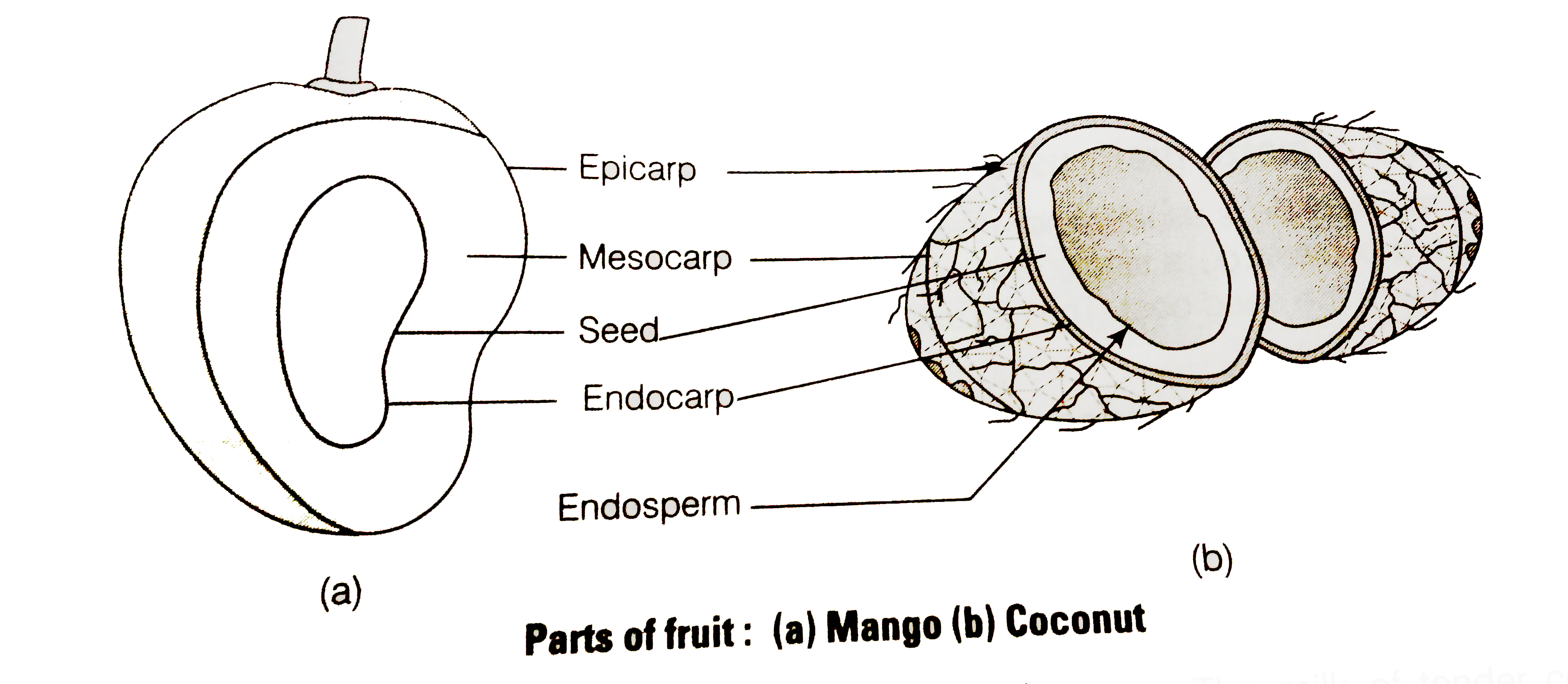Mango and coconut are similar in
having undifferentiated pericarp
arising from multicarpellary syncarpous gynoecium
having mesocarp as edible part
being single seeded
The correct Answer is:4
Step-by-Step Solution:
1. Identify the Fruits: The question compares two fruits: mango and coconut.
2. Understand the Structure of Mango:
- Mango is classified as a juicy drupe fruit.
- It develops from a multicarpillary syncarpous gynoecium, meaning it has multiple carpels that are fused together.
- The pericarp (the fruit wall) of mango is differentiated into three layers:
- Exocarp (outer layer)
- Mesocarp (middle layer, which is the edible part)
- Endocarp (inner layer)
- Mango typically contains a single seed.
3. Understand the Structure of Coconut:
- Coconut is classified as a dry drupe fruit.
- It can arise from a single pistil (monocarpillary) and can be either syncarpous or apocarpous.
- The pericarp of coconut is also differentiated into three layers:
- Exocarp (outer layer)
- Mesocarp (the edible part)
- Endocarp (inner layer)
- Coconut also typically contains a single seed.
4. Compare the Features:
- Undifferentiated Pericarp: Both fruits have differentiated pericarp, so this statement is incorrect for both.
- Multicarpillary Syncarpous Gynoecium: This is true for mango but not for coconut, which can be monocarpillary.
- Mesocarp as Edible Part: This is true for both mango and coconut, as the mesocarp is the edible part in both fruits.
- Single Seed: Both fruits typically have a single seed, but the statement is misleading as mango has a single seed but coconut is also known for having one seed.
5. Conclusion: The only correct similarity between mango and coconut is that both have the mesocarp as the edible part.
Final Answer: Mango and coconut are similar in having the mesocarp as the edible part.
---
- Mango is classified as a juicy drupe fruit.
- It develops from a multicarpillary syncarpous gynoecium, meaning it has multiple carpels that are fused together.
- The pericarp (the fruit wall) of mango is differentiated into three layers:
- Exocarp (outer layer)
- Mesocarp (middle layer, which is the edible part)
- Endocarp (inner layer)
- Mango typically contains a single seed.
- Coconut is classified as a dry drupe fruit.
- It can arise from a single pistil (monocarpillary) and can be either syncarpous or apocarpous.
- The pericarp of coconut is also differentiated into three layers:
- Exocarp (outer layer)
- Mesocarp (the edible part)
- Endocarp (inner layer)
- Coconut also typically contains a single seed.
- Undifferentiated Pericarp: Both fruits have differentiated pericarp, so this statement is incorrect for both.
- Multicarpillary Syncarpous Gynoecium: This is true for mango but not for coconut, which can be monocarpillary.
- Mesocarp as Edible Part: This is true for both mango and coconut, as the mesocarp is the edible part in both fruits.
- Single Seed: Both fruits typically have a single seed, but the statement is misleading as mango has a single seed but coconut is also known for having one seed.
Topper's Solved these Questions
- MORPHOLOGY OF FLOWERINGPLANTS BOOK - VMC MODULES ENGLISHCHAPTER - MORPHOLOGY OF FLOWERINGPLANTS EXERCISE - PRACTICE EXERCISE-(7)
5 Videos
- MORPHOLOGY OF FLOWERINGPLANTS BOOK - VMC MODULES ENGLISHCHAPTER - MORPHOLOGY OF FLOWERINGPLANTS EXERCISE - IN-CHAPTER EXERCISE-A
10 Videos
- MORPHOLOGY OF FLOWERINGPLANTS BOOK - VMC MODULES ENGLISHCHAPTER - MORPHOLOGY OF FLOWERINGPLANTS EXERCISE - PRACTICE EXERCISE-(5)
5 Videos
- MINERAL NUTRITIONBOOK - VMC MODULES ENGLISHCHAPTER - MINERAL NUTRITIONEXERCISE - IMPECCABLE
55 Videos
- ORGANISMS & POPULATIONS BOOK - VMC MODULES ENGLISHCHAPTER - ORGANISMS & POPULATIONS EXERCISE - In - Chapter exercise C
10 Videos
Similar Questions
Mango and coconut are drupe fruits. They develop from monocarpellary superior ovaries and are one seeded. It is differentiated inot outer thin epicarp, middle fleshy mesocarp and inner stony endocarp .

The edible part of coconut (Cocos nucifera) is endosperm . The milk of tender coconut represents the oily endosperm in liquid form. Later it gets deposited along the walls of endocrap and forms edible flesh.
View SolutionCoconut has
View SolutionMango and coconut lie in which category of fruits:-
View SolutionCoconut water is
View SolutionIn Mango and Coconut, the fruit is known as
View SolutionWhich type of fruits are mango and coconut? What is the difference between their mesocarp ?
View SolutionIdentify the correct features of Mango and Coconut fruits.
(i) In both fruit is a drupe
(ii) Endocarp is edible in both
(iii) Mesocarp in Coconut is fibrous,and in Mango it is fleshy
(iv) In both,fruit develops from monocarpellary ovary. Select the correct option from below:
View SolutionFruit of Mango and coconut develops from
View SolutionCoconut milk factor is
View SolutionCoconut fruit is a
View Solution